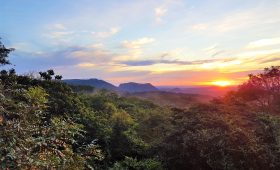Yangmingshan National Park – Taiwan
Welcome to Yangmingshan National Park!
Yangmingshan National Park offers a unique blend of natural beauty and cultural history. Located just a short distance from Taipei, this park is known for its volcanic landscapes, diverse ecosystems, and historical significance. Whether you’re a nature enthusiast or a history buff, Yangmingshan has something to offer. Here’s what you need to know to plan your visit.
Why Visit Yangmingshan National Park?
Yangmingshan National Park stands out for several reasons:
- Volcanic Landscapes: The park features volcanic mountains, including Mount Qixing, the highest peak in Taipei at 1,120 meters (3,674 feet). The area is dotted with fumaroles and hot springs, offering a glimpse into the region’s geothermal activity.
- Biodiversity: Below 1,000 meters, you’ll find subtropical rainforests. Above this elevation, the landscape transitions to scrub-like trees and tall grasses. The park is home to a variety of plant and animal species, making it a haven for nature lovers.
- Historical Significance: Originally named Caoshan, the park was renamed after the Ming philosopher Wang Yang-ming. Historical sites like the Yangming Shuwu and the Lin Yutang House offer insights into Taiwan’s cultural heritage.
- Hiking Trails: The park boasts well-maintained trails, ranging from easy walks to challenging hikes. Trails are paved with basalt and can be steep, so proper footwear is recommended.
Best Time to Visit
Your experience at Yangmingshan can vary greatly depending on the season:
- Spring (March to May): This is the best time to see cherry blossoms and azaleas in full bloom. The park is vibrant with color, attracting many visitors.
- Summer (June to August): Ideal for hiking, the trails are lush and green. However, be prepared for occasional rain and humidity.
- Fall (September to November): Cooler temperatures make for comfortable hiking conditions. The foliage turns into stunning shades of red and orange.
- Winter (December to February): While rare, snowfall can occur, offering a unique perspective of the park. Some trails may be slippery, so caution is advised.
How to Get There
Reaching Yangmingshan National Park is straightforward:
- By Public Transportation: From Taipei Main Station, take Bus 260, which departs every ten minutes. Alternatively, from Jiantan MRT Station, Bus Red 5 leaves every 15 minutes. Both routes take about 40 minutes and cost NT$30.
- By Taxi: Taxis are a convenient option from Taipei. Simply inform the driver of your destination.
- By Private Car: Renting a car is an option, with parking available near the park entrance. Be mindful of narrow and winding roads.
Exploring the Park
Once inside the park, there are several ways to explore:
- Walking: The park’s trails are well-marked and offer varying levels of difficulty. Be prepared for steep sections, especially after rain.
- Biking: While not all trails are suitable for biking, some roads and paths allow for a scenic ride.
- Public Transportation: The 108 bus offers unlimited rides around the park for NT$60, with stops at key locations. Plan for possible wait times between buses.
Notable Attractions
Xiaoyoukeng
This volcanic area is known for its fumaroles and sulfur deposits. The steam vents and bubbling mud pots provide a fascinating look at geothermal activity.
Qingtiangang Grassland
A popular spot for picnics, this grassland offers panoramic views and is often frequented by grazing cattle. It’s a peaceful area to relax and enjoy the scenery.
Lengshuikeng
Known for its hot springs, Lengshuikeng offers both public and private bathing options. The sulfurous waters are said to have therapeutic properties.
Summary
- Yangmingshan National Park offers volcanic landscapes, diverse ecosystems, and historical sites.
- Each season provides a different experience, from spring blossoms to winter snows.
- Accessible by public transport, taxi, or car, the park is easy to reach from Taipei.
- Explore on foot, by bike, or using the park’s shuttle buses.
- Key attractions include Xiaoyoukeng, Qingtiangang, and Lengshuikeng.


